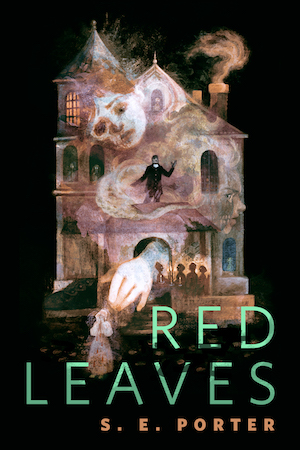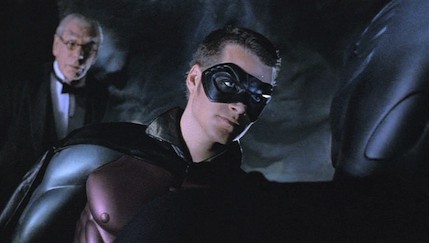Robin has frequently been a controversial figure in the history of Batman comics. Several different characters have worn the costume, as DC has seen fit to alternate between making Batman a loner or deciding he needs a sidekick based on its sense of the prevailing popular preference. The relationship between Bruce Wayne and his various youthful wards has been deemed unsavory by some, first and most notoriously the morality crusader Frederic Wertham in the 1950s. This perception is based far more in the prejudices (or juvenile sense of humor) in the eye of the beholder than it is in the material content of the Batman canon, but it is nonetheless ironic that all this notoriety arose in connection with a character who is most often (re)introduced to the canon as a means to make Batman more family-friendly.
“Family-friendly” was the most frequently-used phrase in explanations why Tim Burton was asked to step aside after directing two pictures and assume a solely producing role in subsequent installments. Warner Bros was dissatisfied with the box-office grosses of Batman Returns and decided that a lighter, less adult tone was what was necessary, and so new director Joel Schumacher, fresh off a commercial success with The Client (featuring a youthful protagonist) was hired.
There’s an element of subjectivity involved in comparing one artist to another, and “darker” is certainly not synonymous with “better.” That being said, defending Joel Schumacher as a director is nearly impossible. His visual choices—having the camera tilted at all kinds of weird random angles and slapping neon on everything, not to mention putting nipples on the Batsuit—have little apparent artistic purpose. All of the above choices were made in the interests of entertainment, and there is certainly nothing wrong with movies being fun, but none of them really serve the movie in any meaningful way, or have anything tangible to do with Batman as a character.
One thing that did was a casting change. Michael Keaton decided not to return, so the role was offered to a very large number of actors, of whom Val Kilmer was selected. Kilmer, an actor known for his habit of “disappearing” into characters, clashed with the director over the way each thought the character should be played. Whether or not this contributed to Kilmer’s flat, affect-less delivery is unclear, but his delivery lacked affect and was flat. It’s a very odd performance, and stands in distinct contrast to almost the entire rest of the cast.
The villains in Batman Forever seem to be in a competition to see who can give the most outrageously over-the-top performance. Jim Carrey’s Riddler and Tommy Lee Jones’s Two-Face (Billy Dee Williams was fired for no given reason, sadly for him: he took the part as Harvey Dent in the ’89 movie specifically to play Two-Face in a sequel) team up to brainwash Gotham’s citizenry with a device Carrey invents as Edward Nygma, scientist in Bruce Wayne’s employ; after Wayne expresses ethical concerns, Nygma becomes the Riddler, and embraces his inner villain. As frenetic as Carrey is here, his performance still works (and in any case he’s no more caffeinated than Frank Gorshin’s incarnation). Jones’ Two-Face matches him step for scenery-chewing step; as this sort of hammy villainy goes, Carrey and Jones make an excellent pair. Their performances suit the surrounding movie neatly.
The conflict in Batman Forever is not merely that between Batman and this nefarious twosome. There’s also a love interest, played by Nicole Kidman, who studies Batman’s psychology and gets kidnapped by the bad guys, and of course, there is Robin. Chris O’Donnell briefly had a career for unknown reasons in the mid-90s, and in Batman Forever he spends almost the entire movie manifesting one default emotion: cocky, unfocused, thoughtless, anger. His endless repetition of this one note, and the exasperatingly stupid actions of the character, make any contribution Robin might have to this movie null and void, and any redemption in the eyes of Robin-haters becomes impossible.
Strangely, in spite of this, Batman Forever is still a reasonably entertaining movie. Its return to the TV show as partial inspiration feels like a bit of a regression in literary terms, but let us not forget, the TV show’s silliness was fun. And whatever one might think of the choice to go lighter from an artistic perspective, it succeeded financially: Batman Forever’s box-office gross neatly split the difference between the first two movies, an indication that the average moviegoer found Forever more to their liking than Returns.
The turbulent relationship between Schumacher and Kilmer led to Kilmer leaving the franchise almost while the movie was still in theaters. After another long casting search, it was decided that George Clooney—then known mainly for his work on TV’s ER, would wear the nippled Batsuit in the next installment of the franchise. Surely nothing could go wrong with that choice? Tune in next time for a discussion of Batman & Robin. And feel perfectly free to call me Shirley, I don’t mind at all.
Danny Bowes is a playwright, filmmaker and blogger. He is also a contributor to nytheatre.com and Premiere.com.










